Hepatitis B and C: Pathogenesis, Diagnosis, and Infection Control
VerifiedAdded on 2023/01/23
|12
|3999
|74
Report
AI Summary
This report provides a detailed analysis of Hepatitis B and C, covering various aspects of the diseases. It begins with an introduction to hepatitis, emphasizing the severity of liver inflammation caused by these viruses. The report then delves into the aetiology, morphology, incidence, and prevalence of both HBV and HCV, including modes of transmission and geographic distribution. The pathophysiology and clinical presentations are discussed, highlighting the impact on the liver and the resulting symptoms. The role of the immune system in disease progression is explored, including the immune responses to both viruses. The report outlines diagnostic methods, including blood tests, liver ultrasounds, and biopsies. Furthermore, it addresses infection prevention and control considerations, emphasizing early diagnosis and awareness. The report also touches on legislative reporting requirements and drug resistance issues. Overall, this report offers a comprehensive overview of Hepatitis B and C, providing valuable insights into these significant public health concerns.

HEPATITIS VIRUS B AND C
Hepatitis Virus B & C
1 | P a g e
Hepatitis Virus B & C
1 | P a g e
Paraphrase This Document
Need a fresh take? Get an instant paraphrase of this document with our AI Paraphraser
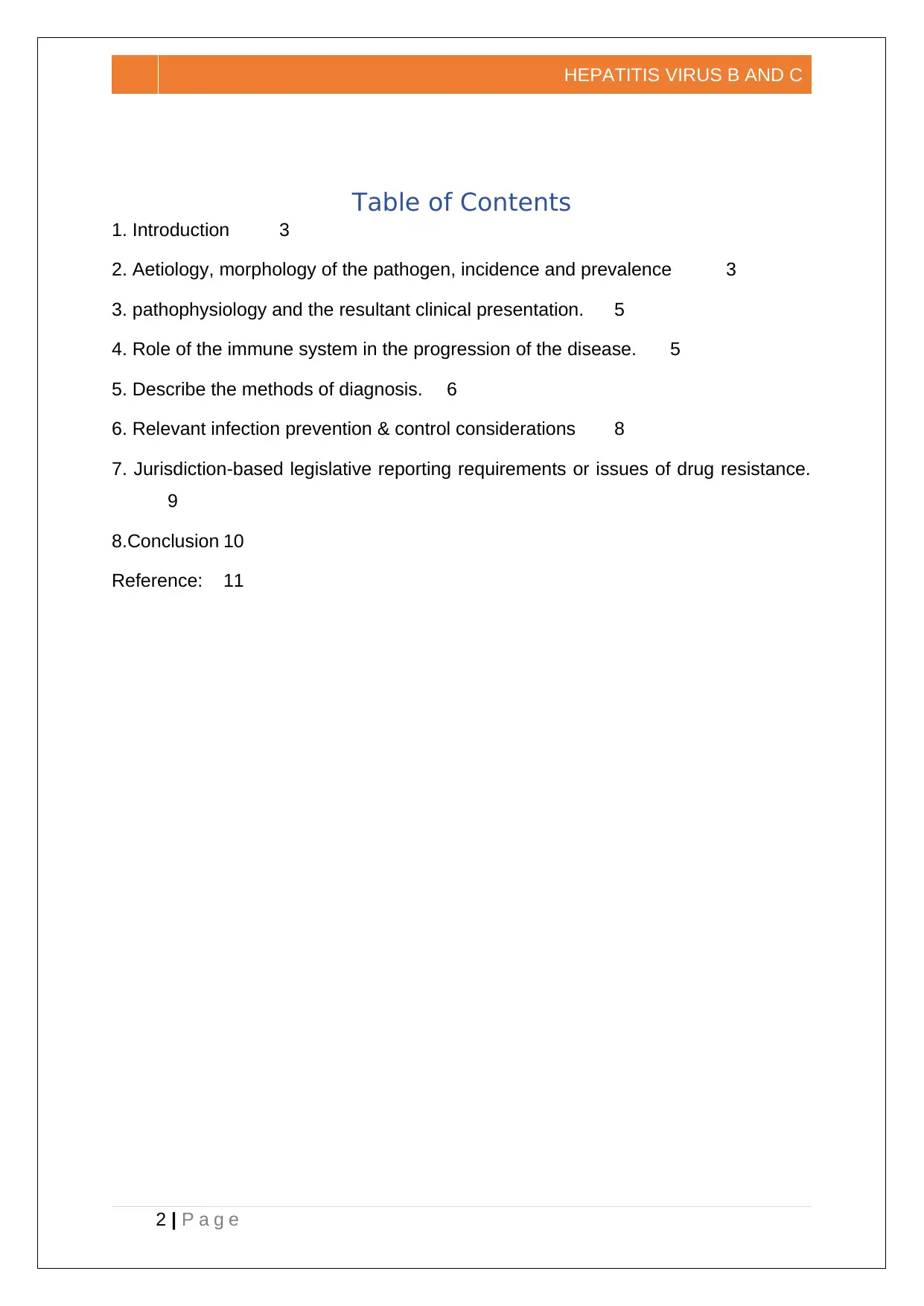
HEPATITIS VIRUS B AND C
Table of Contents
1. Introduction 3
2. Aetiology, morphology of the pathogen, incidence and prevalence 3
3. pathophysiology and the resultant clinical presentation. 5
4. Role of the immune system in the progression of the disease. 5
5. Describe the methods of diagnosis. 6
6. Relevant infection prevention & control considerations 8
7. Jurisdiction-based legislative reporting requirements or issues of drug resistance.
9
8.Conclusion 10
Reference: 11
2 | P a g e
Table of Contents
1. Introduction 3
2. Aetiology, morphology of the pathogen, incidence and prevalence 3
3. pathophysiology and the resultant clinical presentation. 5
4. Role of the immune system in the progression of the disease. 5
5. Describe the methods of diagnosis. 6
6. Relevant infection prevention & control considerations 8
7. Jurisdiction-based legislative reporting requirements or issues of drug resistance.
9
8.Conclusion 10
Reference: 11
2 | P a g e
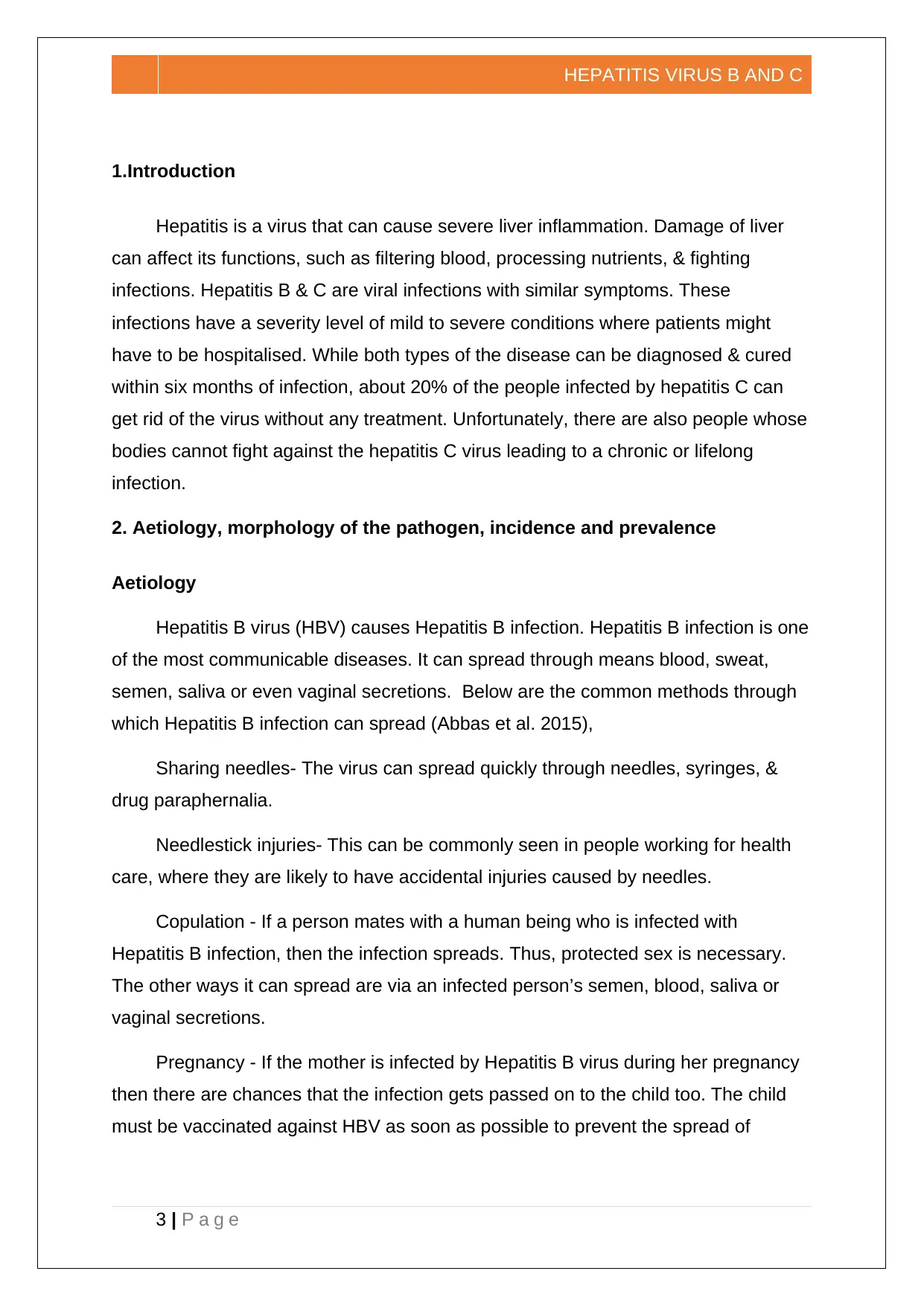
HEPATITIS VIRUS B AND C
1.Introduction
Hepatitis is a virus that can cause severe liver inflammation. Damage of liver
can affect its functions, such as filtering blood, processing nutrients, & fighting
infections. Hepatitis B & C are viral infections with similar symptoms. These
infections have a severity level of mild to severe conditions where patients might
have to be hospitalised. While both types of the disease can be diagnosed & cured
within six months of infection, about 20% of the people infected by hepatitis C can
get rid of the virus without any treatment. Unfortunately, there are also people whose
bodies cannot fight against the hepatitis C virus leading to a chronic or lifelong
infection.
2. Aetiology, morphology of the pathogen, incidence and prevalence
Aetiology
Hepatitis B virus (HBV) causes Hepatitis B infection. Hepatitis B infection is one
of the most communicable diseases. It can spread through means blood, sweat,
semen, saliva or even vaginal secretions. Below are the common methods through
which Hepatitis B infection can spread (Abbas et al. 2015),
Sharing needles- The virus can spread quickly through needles, syringes, &
drug paraphernalia.
Needlestick injuries- This can be commonly seen in people working for health
care, where they are likely to have accidental injuries caused by needles.
Copulation - If a person mates with a human being who is infected with
Hepatitis B infection, then the infection spreads. Thus, protected sex is necessary.
The other ways it can spread are via an infected person’s semen, blood, saliva or
vaginal secretions.
Pregnancy - If the mother is infected by Hepatitis B virus during her pregnancy
then there are chances that the infection gets passed on to the child too. The child
must be vaccinated against HBV as soon as possible to prevent the spread of
3 | P a g e
1.Introduction
Hepatitis is a virus that can cause severe liver inflammation. Damage of liver
can affect its functions, such as filtering blood, processing nutrients, & fighting
infections. Hepatitis B & C are viral infections with similar symptoms. These
infections have a severity level of mild to severe conditions where patients might
have to be hospitalised. While both types of the disease can be diagnosed & cured
within six months of infection, about 20% of the people infected by hepatitis C can
get rid of the virus without any treatment. Unfortunately, there are also people whose
bodies cannot fight against the hepatitis C virus leading to a chronic or lifelong
infection.
2. Aetiology, morphology of the pathogen, incidence and prevalence
Aetiology
Hepatitis B virus (HBV) causes Hepatitis B infection. Hepatitis B infection is one
of the most communicable diseases. It can spread through means blood, sweat,
semen, saliva or even vaginal secretions. Below are the common methods through
which Hepatitis B infection can spread (Abbas et al. 2015),
Sharing needles- The virus can spread quickly through needles, syringes, &
drug paraphernalia.
Needlestick injuries- This can be commonly seen in people working for health
care, where they are likely to have accidental injuries caused by needles.
Copulation - If a person mates with a human being who is infected with
Hepatitis B infection, then the infection spreads. Thus, protected sex is necessary.
The other ways it can spread are via an infected person’s semen, blood, saliva or
vaginal secretions.
Pregnancy - If the mother is infected by Hepatitis B virus during her pregnancy
then there are chances that the infection gets passed on to the child too. The child
must be vaccinated against HBV as soon as possible to prevent the spread of
3 | P a g e
⊘ This is a preview!⊘
Do you want full access?
Subscribe today to unlock all pages.

Trusted by 1+ million students worldwide
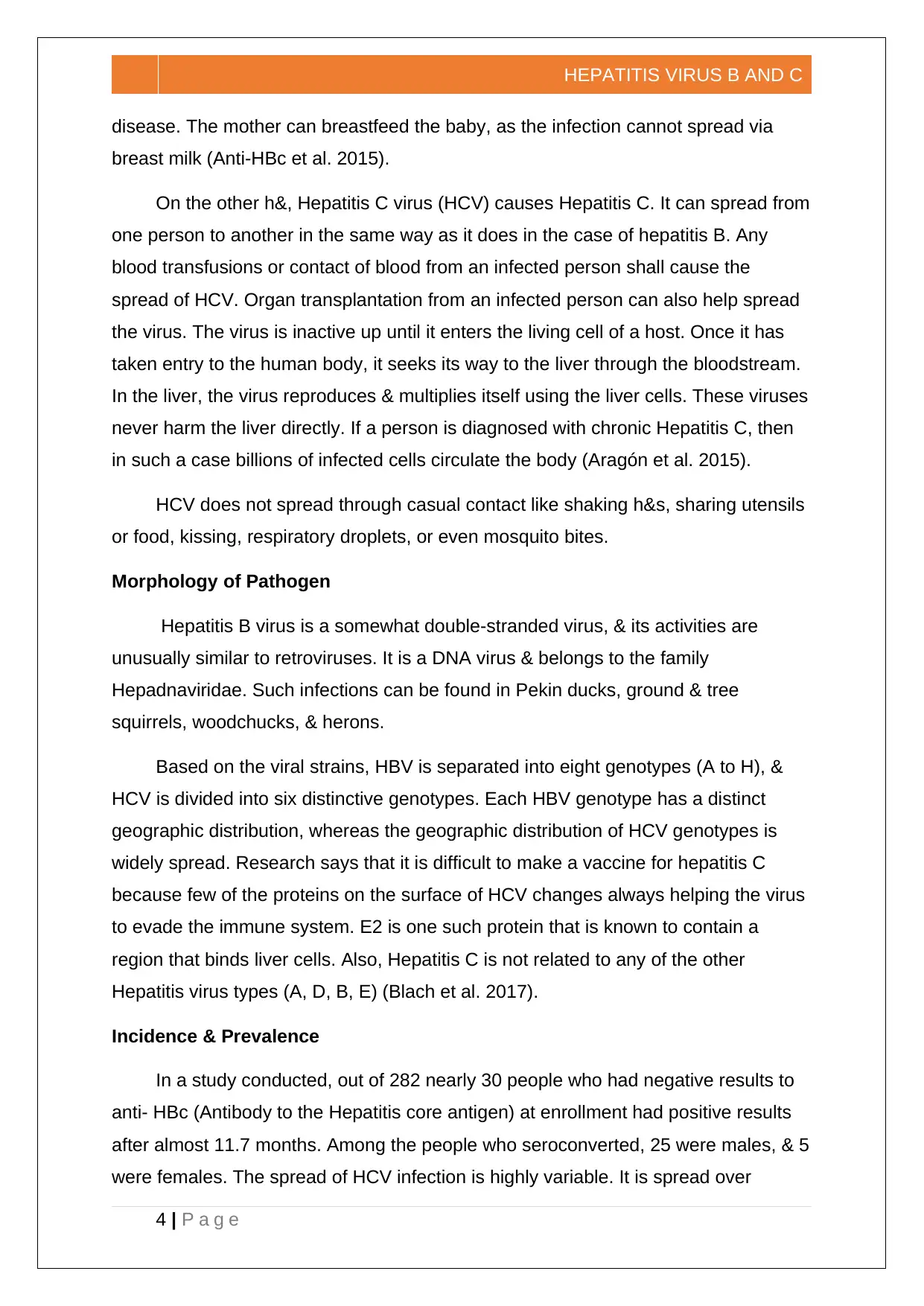
HEPATITIS VIRUS B AND C
disease. The mother can breastfeed the baby, as the infection cannot spread via
breast milk (Anti-HBc et al. 2015).
On the other h&, Hepatitis C virus (HCV) causes Hepatitis C. It can spread from
one person to another in the same way as it does in the case of hepatitis B. Any
blood transfusions or contact of blood from an infected person shall cause the
spread of HCV. Organ transplantation from an infected person can also help spread
the virus. The virus is inactive up until it enters the living cell of a host. Once it has
taken entry to the human body, it seeks its way to the liver through the bloodstream.
In the liver, the virus reproduces & multiplies itself using the liver cells. These viruses
never harm the liver directly. If a person is diagnosed with chronic Hepatitis C, then
in such a case billions of infected cells circulate the body (Aragón et al. 2015).
HCV does not spread through casual contact like shaking h&s, sharing utensils
or food, kissing, respiratory droplets, or even mosquito bites.
Morphology of Pathogen
Hepatitis B virus is a somewhat double-stranded virus, & its activities are
unusually similar to retroviruses. It is a DNA virus & belongs to the family
Hepadnaviridae. Such infections can be found in Pekin ducks, ground & tree
squirrels, woodchucks, & herons.
Based on the viral strains, HBV is separated into eight genotypes (A to H), &
HCV is divided into six distinctive genotypes. Each HBV genotype has a distinct
geographic distribution, whereas the geographic distribution of HCV genotypes is
widely spread. Research says that it is difficult to make a vaccine for hepatitis C
because few of the proteins on the surface of HCV changes always helping the virus
to evade the immune system. E2 is one such protein that is known to contain a
region that binds liver cells. Also, Hepatitis C is not related to any of the other
Hepatitis virus types (A, D, B, E) (Blach et al. 2017).
Incidence & Prevalence
In a study conducted, out of 282 nearly 30 people who had negative results to
anti- HBc (Antibody to the Hepatitis core antigen) at enrollment had positive results
after almost 11.7 months. Among the people who seroconverted, 25 were males, & 5
were females. The spread of HCV infection is highly variable. It is spread over
4 | P a g e
disease. The mother can breastfeed the baby, as the infection cannot spread via
breast milk (Anti-HBc et al. 2015).
On the other h&, Hepatitis C virus (HCV) causes Hepatitis C. It can spread from
one person to another in the same way as it does in the case of hepatitis B. Any
blood transfusions or contact of blood from an infected person shall cause the
spread of HCV. Organ transplantation from an infected person can also help spread
the virus. The virus is inactive up until it enters the living cell of a host. Once it has
taken entry to the human body, it seeks its way to the liver through the bloodstream.
In the liver, the virus reproduces & multiplies itself using the liver cells. These viruses
never harm the liver directly. If a person is diagnosed with chronic Hepatitis C, then
in such a case billions of infected cells circulate the body (Aragón et al. 2015).
HCV does not spread through casual contact like shaking h&s, sharing utensils
or food, kissing, respiratory droplets, or even mosquito bites.
Morphology of Pathogen
Hepatitis B virus is a somewhat double-stranded virus, & its activities are
unusually similar to retroviruses. It is a DNA virus & belongs to the family
Hepadnaviridae. Such infections can be found in Pekin ducks, ground & tree
squirrels, woodchucks, & herons.
Based on the viral strains, HBV is separated into eight genotypes (A to H), &
HCV is divided into six distinctive genotypes. Each HBV genotype has a distinct
geographic distribution, whereas the geographic distribution of HCV genotypes is
widely spread. Research says that it is difficult to make a vaccine for hepatitis C
because few of the proteins on the surface of HCV changes always helping the virus
to evade the immune system. E2 is one such protein that is known to contain a
region that binds liver cells. Also, Hepatitis C is not related to any of the other
Hepatitis virus types (A, D, B, E) (Blach et al. 2017).
Incidence & Prevalence
In a study conducted, out of 282 nearly 30 people who had negative results to
anti- HBc (Antibody to the Hepatitis core antigen) at enrollment had positive results
after almost 11.7 months. Among the people who seroconverted, 25 were males, & 5
were females. The spread of HCV infection is highly variable. It is spread over
4 | P a g e
Paraphrase This Document
Need a fresh take? Get an instant paraphrase of this document with our AI Paraphraser
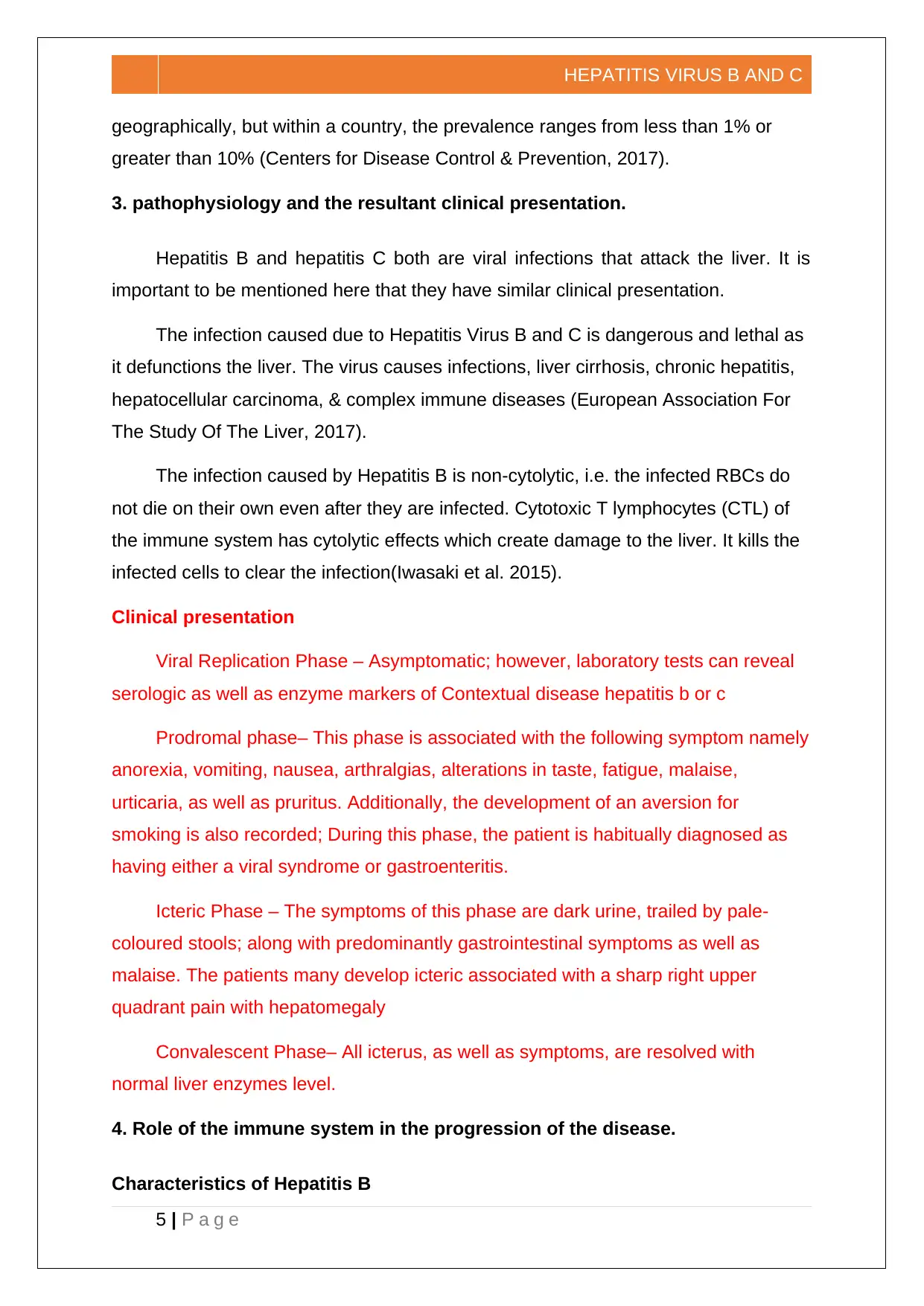
HEPATITIS VIRUS B AND C
geographically, but within a country, the prevalence ranges from less than 1% or
greater than 10% (Centers for Disease Control & Prevention, 2017).
3. pathophysiology and the resultant clinical presentation.
Hepatitis B and hepatitis C both are viral infections that attack the liver. It is
important to be mentioned here that they have similar clinical presentation.
The infection caused due to Hepatitis Virus B and C is dangerous and lethal as
it defunctions the liver. The virus causes infections, liver cirrhosis, chronic hepatitis,
hepatocellular carcinoma, & complex immune diseases (European Association For
The Study Of The Liver, 2017).
The infection caused by Hepatitis B is non-cytolytic, i.e. the infected RBCs do
not die on their own even after they are infected. Cytotoxic T lymphocytes (CTL) of
the immune system has cytolytic effects which create damage to the liver. It kills the
infected cells to clear the infection(Iwasaki et al. 2015).
Clinical presentation
Viral Replication Phase – Asymptomatic; however, laboratory tests can reveal
serologic as well as enzyme markers of Contextual disease hepatitis b or c
Prodromal phase– This phase is associated with the following symptom namely
anorexia, vomiting, nausea, arthralgias, alterations in taste, fatigue, malaise,
urticaria, as well as pruritus. Additionally, the development of an aversion for
smoking is also recorded; During this phase, the patient is habitually diagnosed as
having either a viral syndrome or gastroenteritis.
Icteric Phase – The symptoms of this phase are dark urine, trailed by pale-
coloured stools; along with predominantly gastrointestinal symptoms as well as
malaise. The patients many develop icteric associated with a sharp right upper
quadrant pain with hepatomegaly
Convalescent Phase– All icterus, as well as symptoms, are resolved with
normal liver enzymes level.
4. Role of the immune system in the progression of the disease.
Characteristics of Hepatitis B
5 | P a g e
geographically, but within a country, the prevalence ranges from less than 1% or
greater than 10% (Centers for Disease Control & Prevention, 2017).
3. pathophysiology and the resultant clinical presentation.
Hepatitis B and hepatitis C both are viral infections that attack the liver. It is
important to be mentioned here that they have similar clinical presentation.
The infection caused due to Hepatitis Virus B and C is dangerous and lethal as
it defunctions the liver. The virus causes infections, liver cirrhosis, chronic hepatitis,
hepatocellular carcinoma, & complex immune diseases (European Association For
The Study Of The Liver, 2017).
The infection caused by Hepatitis B is non-cytolytic, i.e. the infected RBCs do
not die on their own even after they are infected. Cytotoxic T lymphocytes (CTL) of
the immune system has cytolytic effects which create damage to the liver. It kills the
infected cells to clear the infection(Iwasaki et al. 2015).
Clinical presentation
Viral Replication Phase – Asymptomatic; however, laboratory tests can reveal
serologic as well as enzyme markers of Contextual disease hepatitis b or c
Prodromal phase– This phase is associated with the following symptom namely
anorexia, vomiting, nausea, arthralgias, alterations in taste, fatigue, malaise,
urticaria, as well as pruritus. Additionally, the development of an aversion for
smoking is also recorded; During this phase, the patient is habitually diagnosed as
having either a viral syndrome or gastroenteritis.
Icteric Phase – The symptoms of this phase are dark urine, trailed by pale-
coloured stools; along with predominantly gastrointestinal symptoms as well as
malaise. The patients many develop icteric associated with a sharp right upper
quadrant pain with hepatomegaly
Convalescent Phase– All icterus, as well as symptoms, are resolved with
normal liver enzymes level.
4. Role of the immune system in the progression of the disease.
Characteristics of Hepatitis B
5 | P a g e
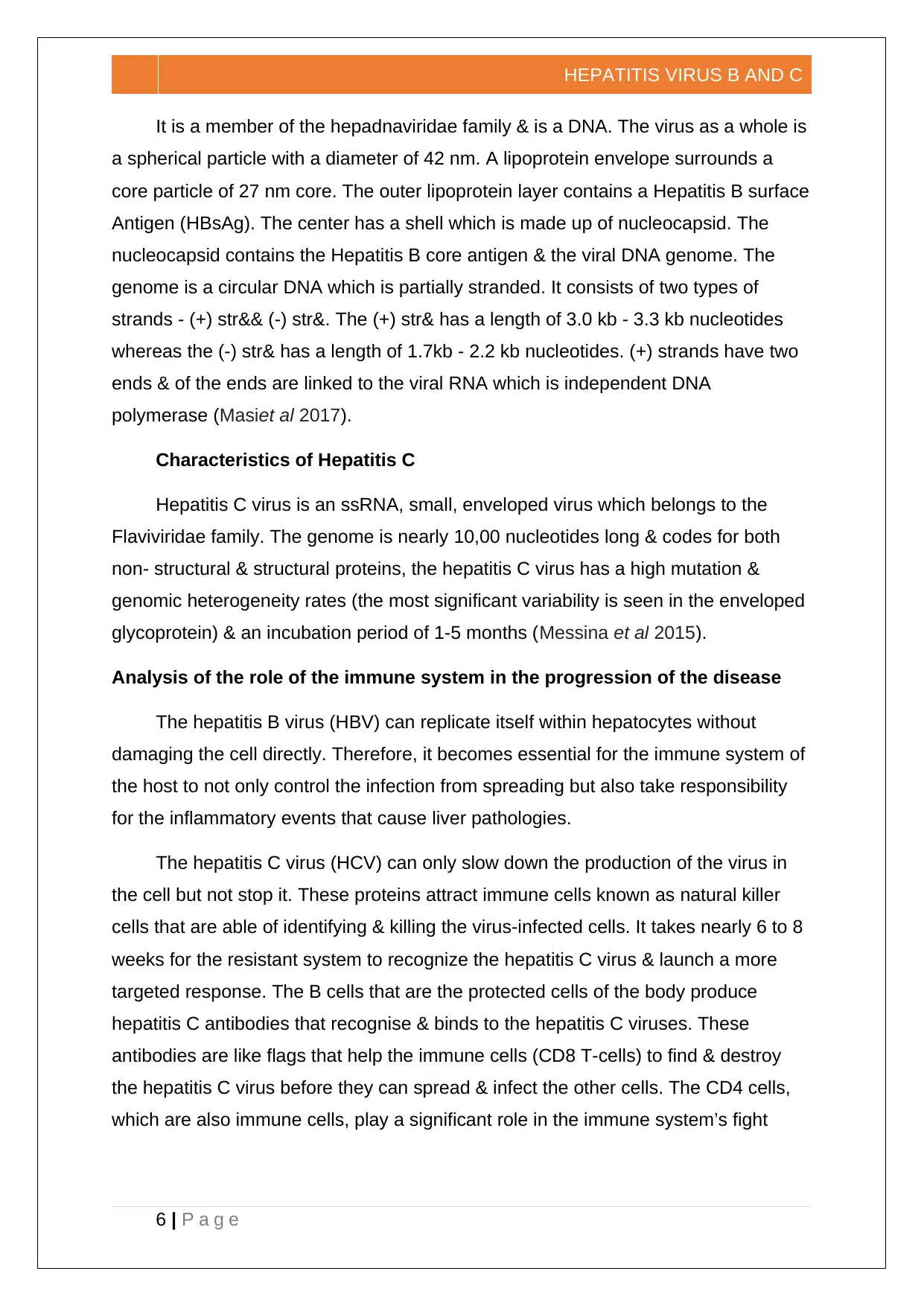
HEPATITIS VIRUS B AND C
It is a member of the hepadnaviridae family & is a DNA. The virus as a whole is
a spherical particle with a diameter of 42 nm. A lipoprotein envelope surrounds a
core particle of 27 nm core. The outer lipoprotein layer contains a Hepatitis B surface
Antigen (HBsAg). The center has a shell which is made up of nucleocapsid. The
nucleocapsid contains the Hepatitis B core antigen & the viral DNA genome. The
genome is a circular DNA which is partially stranded. It consists of two types of
strands - (+) str&& (-) str&. The (+) str& has a length of 3.0 kb - 3.3 kb nucleotides
whereas the (-) str& has a length of 1.7kb - 2.2 kb nucleotides. (+) strands have two
ends & of the ends are linked to the viral RNA which is independent DNA
polymerase (Masiet al 2017).
Characteristics of Hepatitis C
Hepatitis C virus is an ssRNA, small, enveloped virus which belongs to the
Flaviviridae family. The genome is nearly 10,00 nucleotides long & codes for both
non- structural & structural proteins, the hepatitis C virus has a high mutation &
genomic heterogeneity rates (the most significant variability is seen in the enveloped
glycoprotein) & an incubation period of 1-5 months (Messina et al 2015).
Analysis of the role of the immune system in the progression of the disease
The hepatitis B virus (HBV) can replicate itself within hepatocytes without
damaging the cell directly. Therefore, it becomes essential for the immune system of
the host to not only control the infection from spreading but also take responsibility
for the inflammatory events that cause liver pathologies.
The hepatitis C virus (HCV) can only slow down the production of the virus in
the cell but not stop it. These proteins attract immune cells known as natural killer
cells that are able of identifying & killing the virus-infected cells. It takes nearly 6 to 8
weeks for the resistant system to recognize the hepatitis C virus & launch a more
targeted response. The B cells that are the protected cells of the body produce
hepatitis C antibodies that recognise & binds to the hepatitis C viruses. These
antibodies are like flags that help the immune cells (CD8 T-cells) to find & destroy
the hepatitis C virus before they can spread & infect the other cells. The CD4 cells,
which are also immune cells, play a significant role in the immune system’s fight
6 | P a g e
It is a member of the hepadnaviridae family & is a DNA. The virus as a whole is
a spherical particle with a diameter of 42 nm. A lipoprotein envelope surrounds a
core particle of 27 nm core. The outer lipoprotein layer contains a Hepatitis B surface
Antigen (HBsAg). The center has a shell which is made up of nucleocapsid. The
nucleocapsid contains the Hepatitis B core antigen & the viral DNA genome. The
genome is a circular DNA which is partially stranded. It consists of two types of
strands - (+) str&& (-) str&. The (+) str& has a length of 3.0 kb - 3.3 kb nucleotides
whereas the (-) str& has a length of 1.7kb - 2.2 kb nucleotides. (+) strands have two
ends & of the ends are linked to the viral RNA which is independent DNA
polymerase (Masiet al 2017).
Characteristics of Hepatitis C
Hepatitis C virus is an ssRNA, small, enveloped virus which belongs to the
Flaviviridae family. The genome is nearly 10,00 nucleotides long & codes for both
non- structural & structural proteins, the hepatitis C virus has a high mutation &
genomic heterogeneity rates (the most significant variability is seen in the enveloped
glycoprotein) & an incubation period of 1-5 months (Messina et al 2015).
Analysis of the role of the immune system in the progression of the disease
The hepatitis B virus (HBV) can replicate itself within hepatocytes without
damaging the cell directly. Therefore, it becomes essential for the immune system of
the host to not only control the infection from spreading but also take responsibility
for the inflammatory events that cause liver pathologies.
The hepatitis C virus (HCV) can only slow down the production of the virus in
the cell but not stop it. These proteins attract immune cells known as natural killer
cells that are able of identifying & killing the virus-infected cells. It takes nearly 6 to 8
weeks for the resistant system to recognize the hepatitis C virus & launch a more
targeted response. The B cells that are the protected cells of the body produce
hepatitis C antibodies that recognise & binds to the hepatitis C viruses. These
antibodies are like flags that help the immune cells (CD8 T-cells) to find & destroy
the hepatitis C virus before they can spread & infect the other cells. The CD4 cells,
which are also immune cells, play a significant role in the immune system’s fight
6 | P a g e
⊘ This is a preview!⊘
Do you want full access?
Subscribe today to unlock all pages.

Trusted by 1+ million students worldwide
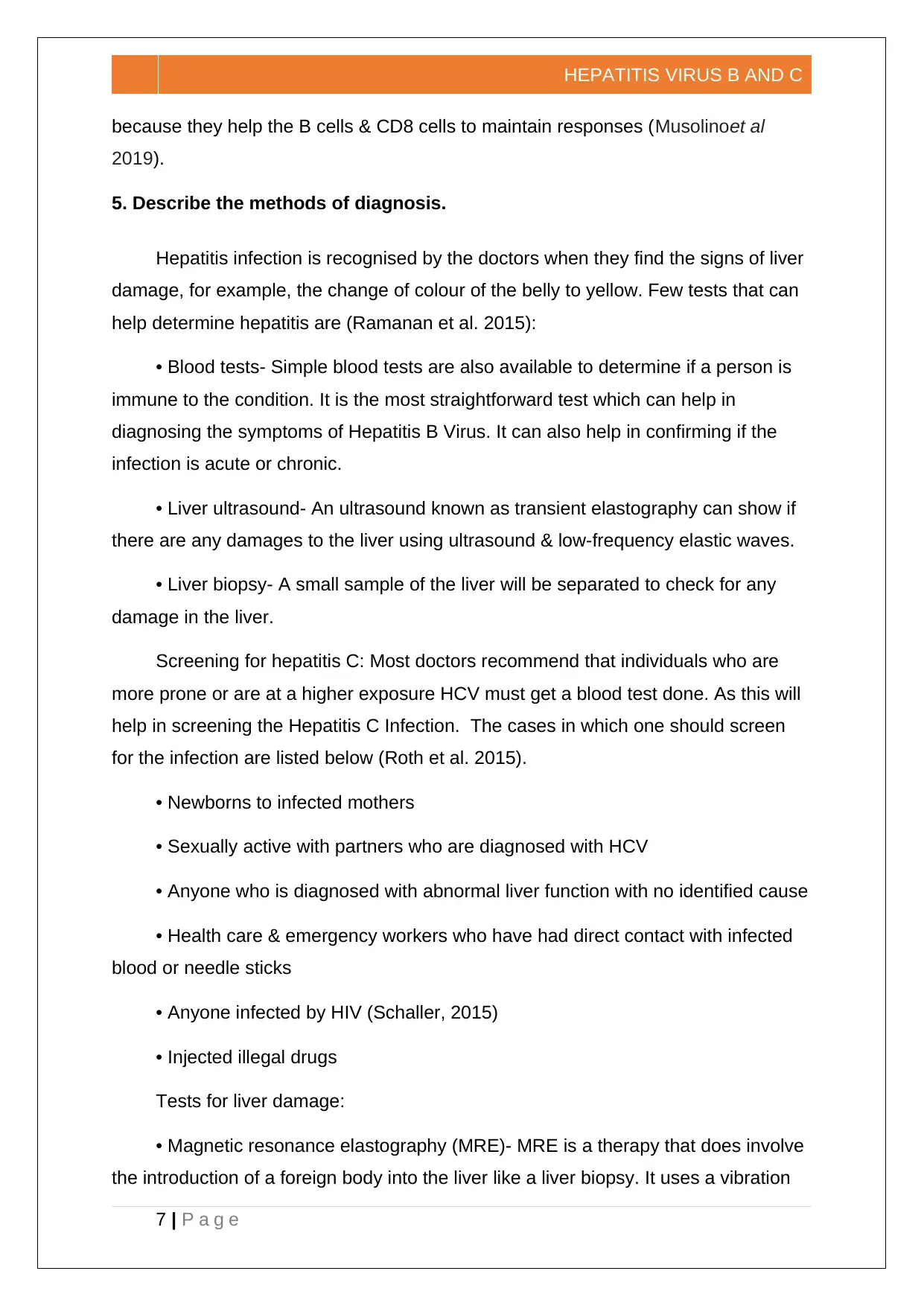
HEPATITIS VIRUS B AND C
because they help the B cells & CD8 cells to maintain responses (Musolinoet al
2019).
5. Describe the methods of diagnosis.
Hepatitis infection is recognised by the doctors when they find the signs of liver
damage, for example, the change of colour of the belly to yellow. Few tests that can
help determine hepatitis are (Ramanan et al. 2015):
• Blood tests- Simple blood tests are also available to determine if a person is
immune to the condition. It is the most straightforward test which can help in
diagnosing the symptoms of Hepatitis B Virus. It can also help in confirming if the
infection is acute or chronic.
• Liver ultrasound- An ultrasound known as transient elastography can show if
there are any damages to the liver using ultrasound & low-frequency elastic waves.
• Liver biopsy- A small sample of the liver will be separated to check for any
damage in the liver.
Screening for hepatitis C: Most doctors recommend that individuals who are
more prone or are at a higher exposure HCV must get a blood test done. As this will
help in screening the Hepatitis C Infection. The cases in which one should screen
for the infection are listed below (Roth et al. 2015).
• Newborns to infected mothers
• Sexually active with partners who are diagnosed with HCV
• Anyone who is diagnosed with abnormal liver function with no identified cause
• Health care & emergency workers who have had direct contact with infected
blood or needle sticks
• Anyone infected by HIV (Schaller, 2015)
• Injected illegal drugs
Tests for liver damage:
• Magnetic resonance elastography (MRE)- MRE is a therapy that does involve
the introduction of a foreign body into the liver like a liver biopsy. It uses a vibration
7 | P a g e
because they help the B cells & CD8 cells to maintain responses (Musolinoet al
2019).
5. Describe the methods of diagnosis.
Hepatitis infection is recognised by the doctors when they find the signs of liver
damage, for example, the change of colour of the belly to yellow. Few tests that can
help determine hepatitis are (Ramanan et al. 2015):
• Blood tests- Simple blood tests are also available to determine if a person is
immune to the condition. It is the most straightforward test which can help in
diagnosing the symptoms of Hepatitis B Virus. It can also help in confirming if the
infection is acute or chronic.
• Liver ultrasound- An ultrasound known as transient elastography can show if
there are any damages to the liver using ultrasound & low-frequency elastic waves.
• Liver biopsy- A small sample of the liver will be separated to check for any
damage in the liver.
Screening for hepatitis C: Most doctors recommend that individuals who are
more prone or are at a higher exposure HCV must get a blood test done. As this will
help in screening the Hepatitis C Infection. The cases in which one should screen
for the infection are listed below (Roth et al. 2015).
• Newborns to infected mothers
• Sexually active with partners who are diagnosed with HCV
• Anyone who is diagnosed with abnormal liver function with no identified cause
• Health care & emergency workers who have had direct contact with infected
blood or needle sticks
• Anyone infected by HIV (Schaller, 2015)
• Injected illegal drugs
Tests for liver damage:
• Magnetic resonance elastography (MRE)- MRE is a therapy that does involve
the introduction of a foreign body into the liver like a liver biopsy. It uses a vibration
7 | P a g e
Paraphrase This Document
Need a fresh take? Get an instant paraphrase of this document with our AI Paraphraser
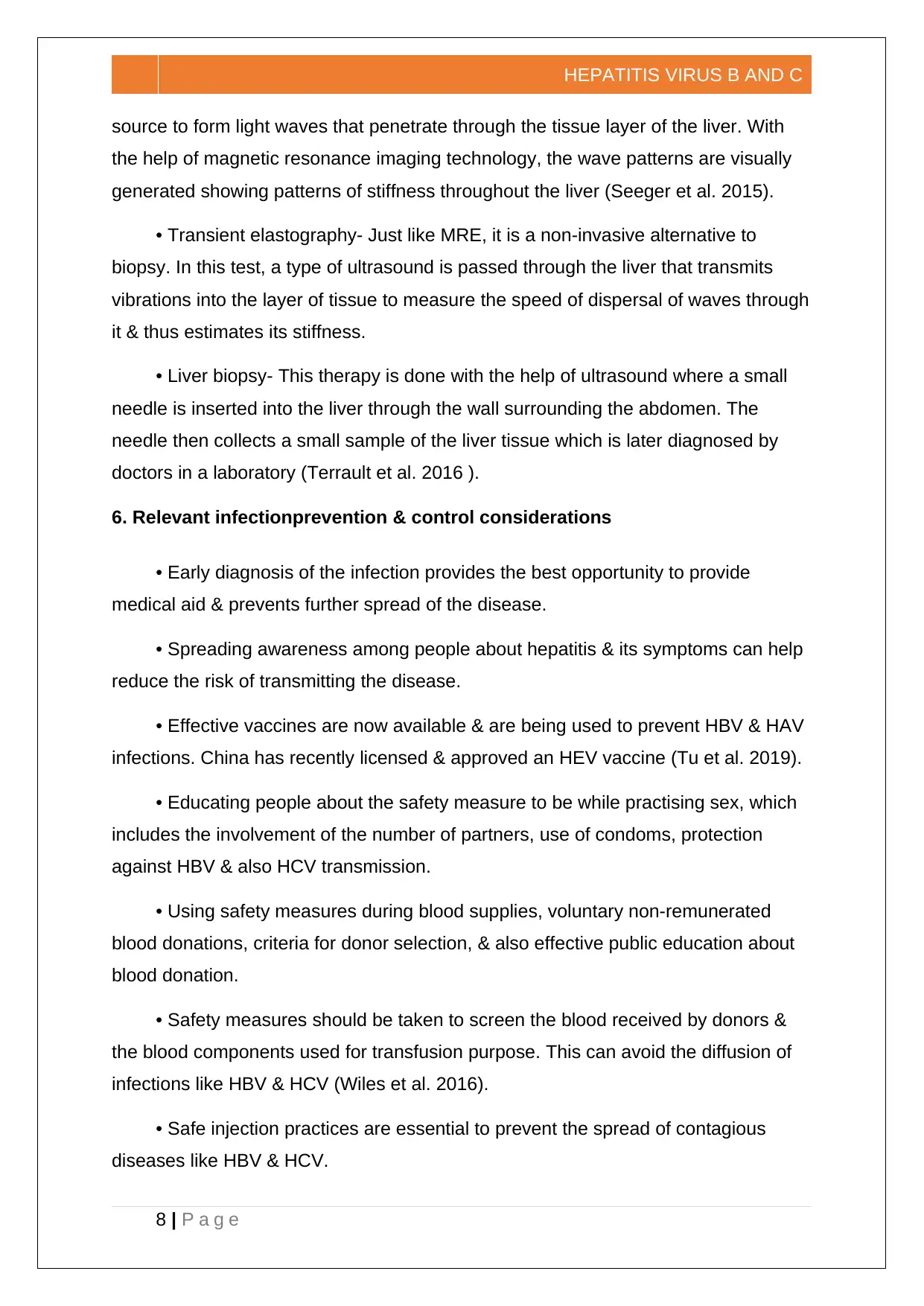
HEPATITIS VIRUS B AND C
source to form light waves that penetrate through the tissue layer of the liver. With
the help of magnetic resonance imaging technology, the wave patterns are visually
generated showing patterns of stiffness throughout the liver (Seeger et al. 2015).
• Transient elastography- Just like MRE, it is a non-invasive alternative to
biopsy. In this test, a type of ultrasound is passed through the liver that transmits
vibrations into the layer of tissue to measure the speed of dispersal of waves through
it & thus estimates its stiffness.
• Liver biopsy- This therapy is done with the help of ultrasound where a small
needle is inserted into the liver through the wall surrounding the abdomen. The
needle then collects a small sample of the liver tissue which is later diagnosed by
doctors in a laboratory (Terrault et al. 2016 ).
6. Relevant infectionprevention & control considerations
• Early diagnosis of the infection provides the best opportunity to provide
medical aid & prevents further spread of the disease.
• Spreading awareness among people about hepatitis & its symptoms can help
reduce the risk of transmitting the disease.
• Effective vaccines are now available & are being used to prevent HBV & HAV
infections. China has recently licensed & approved an HEV vaccine (Tu et al. 2019).
• Educating people about the safety measure to be while practising sex, which
includes the involvement of the number of partners, use of condoms, protection
against HBV & also HCV transmission.
• Using safety measures during blood supplies, voluntary non-remunerated
blood donations, criteria for donor selection, & also effective public education about
blood donation.
• Safety measures should be taken to screen the blood received by donors &
the blood components used for transfusion purpose. This can avoid the diffusion of
infections like HBV & HCV (Wiles et al. 2016).
• Safe injection practices are essential to prevent the spread of contagious
diseases like HBV & HCV.
8 | P a g e
source to form light waves that penetrate through the tissue layer of the liver. With
the help of magnetic resonance imaging technology, the wave patterns are visually
generated showing patterns of stiffness throughout the liver (Seeger et al. 2015).
• Transient elastography- Just like MRE, it is a non-invasive alternative to
biopsy. In this test, a type of ultrasound is passed through the liver that transmits
vibrations into the layer of tissue to measure the speed of dispersal of waves through
it & thus estimates its stiffness.
• Liver biopsy- This therapy is done with the help of ultrasound where a small
needle is inserted into the liver through the wall surrounding the abdomen. The
needle then collects a small sample of the liver tissue which is later diagnosed by
doctors in a laboratory (Terrault et al. 2016 ).
6. Relevant infectionprevention & control considerations
• Early diagnosis of the infection provides the best opportunity to provide
medical aid & prevents further spread of the disease.
• Spreading awareness among people about hepatitis & its symptoms can help
reduce the risk of transmitting the disease.
• Effective vaccines are now available & are being used to prevent HBV & HAV
infections. China has recently licensed & approved an HEV vaccine (Tu et al. 2019).
• Educating people about the safety measure to be while practising sex, which
includes the involvement of the number of partners, use of condoms, protection
against HBV & also HCV transmission.
• Using safety measures during blood supplies, voluntary non-remunerated
blood donations, criteria for donor selection, & also effective public education about
blood donation.
• Safety measures should be taken to screen the blood received by donors &
the blood components used for transfusion purpose. This can avoid the diffusion of
infections like HBV & HCV (Wiles et al. 2016).
• Safe injection practices are essential to prevent the spread of contagious
diseases like HBV & HCV.
8 | P a g e
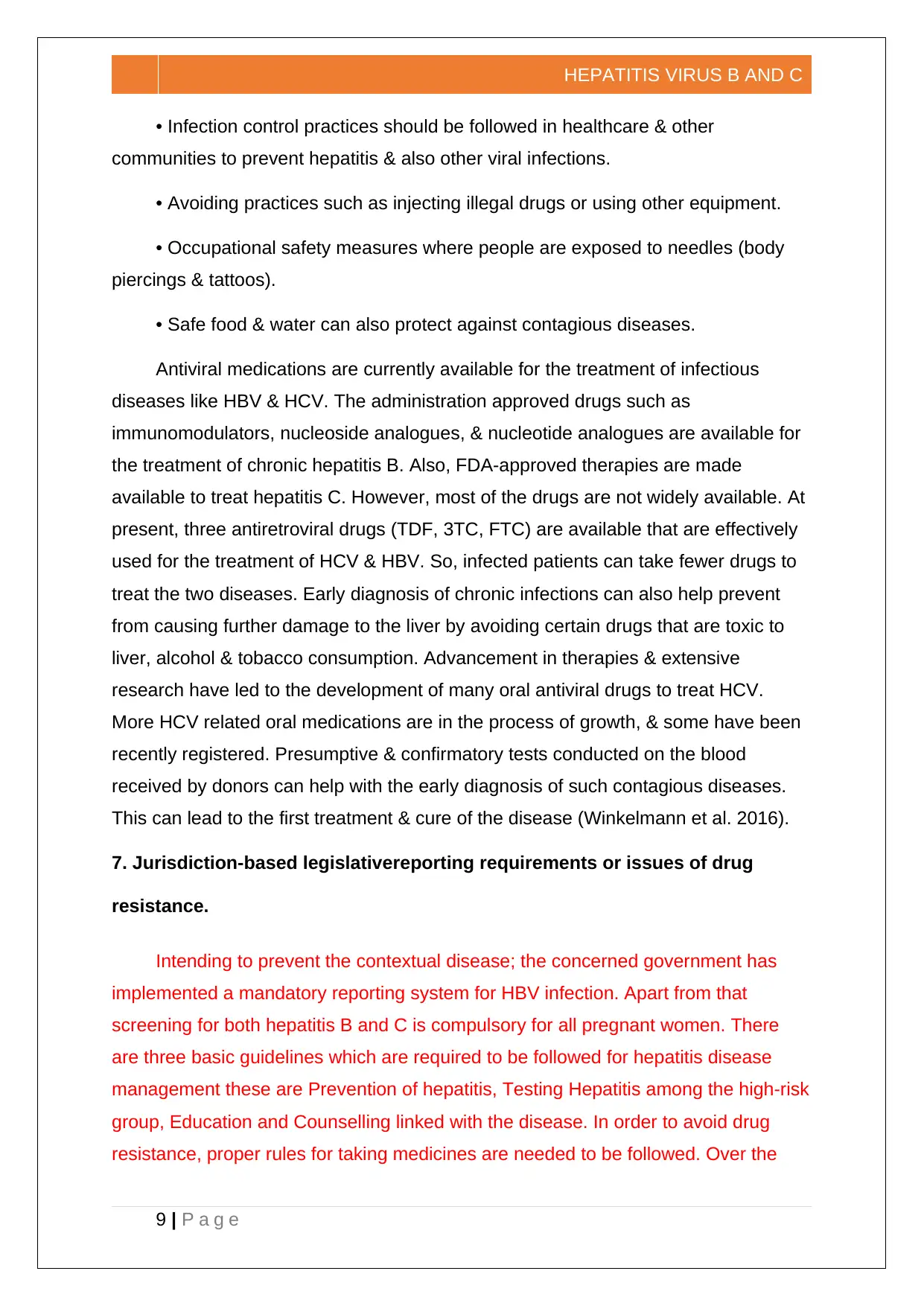
HEPATITIS VIRUS B AND C
• Infection control practices should be followed in healthcare & other
communities to prevent hepatitis & also other viral infections.
• Avoiding practices such as injecting illegal drugs or using other equipment.
• Occupational safety measures where people are exposed to needles (body
piercings & tattoos).
• Safe food & water can also protect against contagious diseases.
Antiviral medications are currently available for the treatment of infectious
diseases like HBV & HCV. The administration approved drugs such as
immunomodulators, nucleoside analogues, & nucleotide analogues are available for
the treatment of chronic hepatitis B. Also, FDA-approved therapies are made
available to treat hepatitis C. However, most of the drugs are not widely available. At
present, three antiretroviral drugs (TDF, 3TC, FTC) are available that are effectively
used for the treatment of HCV & HBV. So, infected patients can take fewer drugs to
treat the two diseases. Early diagnosis of chronic infections can also help prevent
from causing further damage to the liver by avoiding certain drugs that are toxic to
liver, alcohol & tobacco consumption. Advancement in therapies & extensive
research have led to the development of many oral antiviral drugs to treat HCV.
More HCV related oral medications are in the process of growth, & some have been
recently registered. Presumptive & confirmatory tests conducted on the blood
received by donors can help with the early diagnosis of such contagious diseases.
This can lead to the first treatment & cure of the disease (Winkelmann et al. 2016).
7. Jurisdiction-based legislativereporting requirements or issues of drug
resistance.
Intending to prevent the contextual disease; the concerned government has
implemented a mandatory reporting system for HBV infection. Apart from that
screening for both hepatitis B and C is compulsory for all pregnant women. There
are three basic guidelines which are required to be followed for hepatitis disease
management these are Prevention of hepatitis, Testing Hepatitis among the high-risk
group, Education and Counselling linked with the disease. In order to avoid drug
resistance, proper rules for taking medicines are needed to be followed. Over the
9 | P a g e
• Infection control practices should be followed in healthcare & other
communities to prevent hepatitis & also other viral infections.
• Avoiding practices such as injecting illegal drugs or using other equipment.
• Occupational safety measures where people are exposed to needles (body
piercings & tattoos).
• Safe food & water can also protect against contagious diseases.
Antiviral medications are currently available for the treatment of infectious
diseases like HBV & HCV. The administration approved drugs such as
immunomodulators, nucleoside analogues, & nucleotide analogues are available for
the treatment of chronic hepatitis B. Also, FDA-approved therapies are made
available to treat hepatitis C. However, most of the drugs are not widely available. At
present, three antiretroviral drugs (TDF, 3TC, FTC) are available that are effectively
used for the treatment of HCV & HBV. So, infected patients can take fewer drugs to
treat the two diseases. Early diagnosis of chronic infections can also help prevent
from causing further damage to the liver by avoiding certain drugs that are toxic to
liver, alcohol & tobacco consumption. Advancement in therapies & extensive
research have led to the development of many oral antiviral drugs to treat HCV.
More HCV related oral medications are in the process of growth, & some have been
recently registered. Presumptive & confirmatory tests conducted on the blood
received by donors can help with the early diagnosis of such contagious diseases.
This can lead to the first treatment & cure of the disease (Winkelmann et al. 2016).
7. Jurisdiction-based legislativereporting requirements or issues of drug
resistance.
Intending to prevent the contextual disease; the concerned government has
implemented a mandatory reporting system for HBV infection. Apart from that
screening for both hepatitis B and C is compulsory for all pregnant women. There
are three basic guidelines which are required to be followed for hepatitis disease
management these are Prevention of hepatitis, Testing Hepatitis among the high-risk
group, Education and Counselling linked with the disease. In order to avoid drug
resistance, proper rules for taking medicines are needed to be followed. Over the
9 | P a g e
⊘ This is a preview!⊘
Do you want full access?
Subscribe today to unlock all pages.

Trusted by 1+ million students worldwide
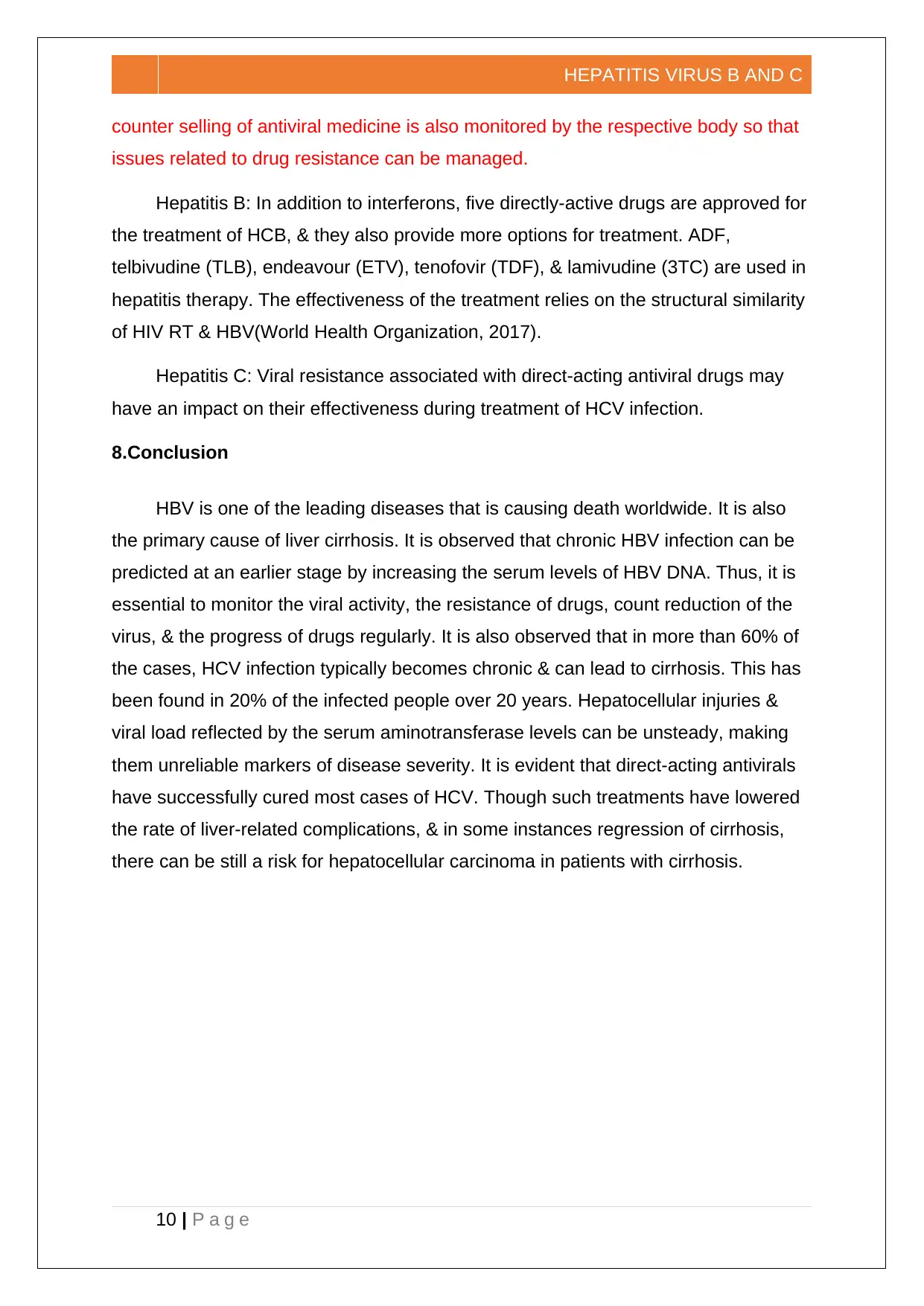
HEPATITIS VIRUS B AND C
counter selling of antiviral medicine is also monitored by the respective body so that
issues related to drug resistance can be managed.
Hepatitis B: In addition to interferons, five directly-active drugs are approved for
the treatment of HCB, & they also provide more options for treatment. ADF,
telbivudine (TLB), endeavour (ETV), tenofovir (TDF), & lamivudine (3TC) are used in
hepatitis therapy. The effectiveness of the treatment relies on the structural similarity
of HIV RT & HBV(World Health Organization, 2017).
Hepatitis C: Viral resistance associated with direct-acting antiviral drugs may
have an impact on their effectiveness during treatment of HCV infection.
8.Conclusion
HBV is one of the leading diseases that is causing death worldwide. It is also
the primary cause of liver cirrhosis. It is observed that chronic HBV infection can be
predicted at an earlier stage by increasing the serum levels of HBV DNA. Thus, it is
essential to monitor the viral activity, the resistance of drugs, count reduction of the
virus, & the progress of drugs regularly. It is also observed that in more than 60% of
the cases, HCV infection typically becomes chronic & can lead to cirrhosis. This has
been found in 20% of the infected people over 20 years. Hepatocellular injuries &
viral load reflected by the serum aminotransferase levels can be unsteady, making
them unreliable markers of disease severity. It is evident that direct-acting antivirals
have successfully cured most cases of HCV. Though such treatments have lowered
the rate of liver-related complications, & in some instances regression of cirrhosis,
there can be still a risk for hepatocellular carcinoma in patients with cirrhosis.
10 | P a g e
counter selling of antiviral medicine is also monitored by the respective body so that
issues related to drug resistance can be managed.
Hepatitis B: In addition to interferons, five directly-active drugs are approved for
the treatment of HCB, & they also provide more options for treatment. ADF,
telbivudine (TLB), endeavour (ETV), tenofovir (TDF), & lamivudine (3TC) are used in
hepatitis therapy. The effectiveness of the treatment relies on the structural similarity
of HIV RT & HBV(World Health Organization, 2017).
Hepatitis C: Viral resistance associated with direct-acting antiviral drugs may
have an impact on their effectiveness during treatment of HCV infection.
8.Conclusion
HBV is one of the leading diseases that is causing death worldwide. It is also
the primary cause of liver cirrhosis. It is observed that chronic HBV infection can be
predicted at an earlier stage by increasing the serum levels of HBV DNA. Thus, it is
essential to monitor the viral activity, the resistance of drugs, count reduction of the
virus, & the progress of drugs regularly. It is also observed that in more than 60% of
the cases, HCV infection typically becomes chronic & can lead to cirrhosis. This has
been found in 20% of the infected people over 20 years. Hepatocellular injuries &
viral load reflected by the serum aminotransferase levels can be unsteady, making
them unreliable markers of disease severity. It is evident that direct-acting antivirals
have successfully cured most cases of HCV. Though such treatments have lowered
the rate of liver-related complications, & in some instances regression of cirrhosis,
there can be still a risk for hepatocellular carcinoma in patients with cirrhosis.
10 | P a g e
Paraphrase This Document
Need a fresh take? Get an instant paraphrase of this document with our AI Paraphraser
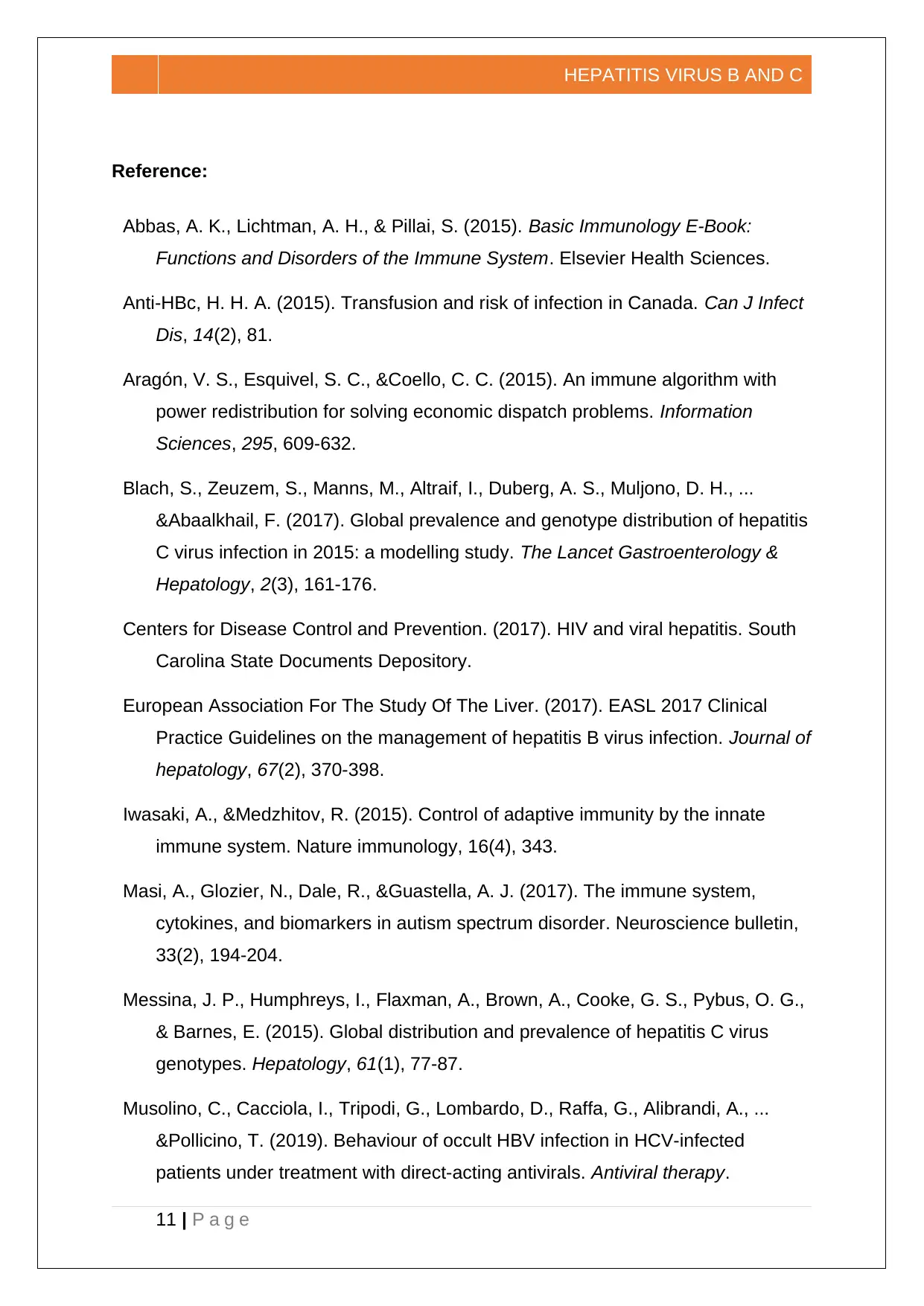
HEPATITIS VIRUS B AND C
Reference:
Abbas, A. K., Lichtman, A. H., & Pillai, S. (2015). Basic Immunology E-Book:
Functions and Disorders of the Immune System. Elsevier Health Sciences.
Anti-HBc, H. H. A. (2015). Transfusion and risk of infection in Canada. Can J Infect
Dis, 14(2), 81.
Aragón, V. S., Esquivel, S. C., &Coello, C. C. (2015). An immune algorithm with
power redistribution for solving economic dispatch problems. Information
Sciences, 295, 609-632.
Blach, S., Zeuzem, S., Manns, M., Altraif, I., Duberg, A. S., Muljono, D. H., ...
&Abaalkhail, F. (2017). Global prevalence and genotype distribution of hepatitis
C virus infection in 2015: a modelling study. The Lancet Gastroenterology &
Hepatology, 2(3), 161-176.
Centers for Disease Control and Prevention. (2017). HIV and viral hepatitis. South
Carolina State Documents Depository.
European Association For The Study Of The Liver. (2017). EASL 2017 Clinical
Practice Guidelines on the management of hepatitis B virus infection. Journal of
hepatology, 67(2), 370-398.
Iwasaki, A., &Medzhitov, R. (2015). Control of adaptive immunity by the innate
immune system. Nature immunology, 16(4), 343.
Masi, A., Glozier, N., Dale, R., &Guastella, A. J. (2017). The immune system,
cytokines, and biomarkers in autism spectrum disorder. Neuroscience bulletin,
33(2), 194-204.
Messina, J. P., Humphreys, I., Flaxman, A., Brown, A., Cooke, G. S., Pybus, O. G.,
& Barnes, E. (2015). Global distribution and prevalence of hepatitis C virus
genotypes. Hepatology, 61(1), 77-87.
Musolino, C., Cacciola, I., Tripodi, G., Lombardo, D., Raffa, G., Alibrandi, A., ...
&Pollicino, T. (2019). Behaviour of occult HBV infection in HCV-infected
patients under treatment with direct-acting antivirals. Antiviral therapy.
11 | P a g e
Reference:
Abbas, A. K., Lichtman, A. H., & Pillai, S. (2015). Basic Immunology E-Book:
Functions and Disorders of the Immune System. Elsevier Health Sciences.
Anti-HBc, H. H. A. (2015). Transfusion and risk of infection in Canada. Can J Infect
Dis, 14(2), 81.
Aragón, V. S., Esquivel, S. C., &Coello, C. C. (2015). An immune algorithm with
power redistribution for solving economic dispatch problems. Information
Sciences, 295, 609-632.
Blach, S., Zeuzem, S., Manns, M., Altraif, I., Duberg, A. S., Muljono, D. H., ...
&Abaalkhail, F. (2017). Global prevalence and genotype distribution of hepatitis
C virus infection in 2015: a modelling study. The Lancet Gastroenterology &
Hepatology, 2(3), 161-176.
Centers for Disease Control and Prevention. (2017). HIV and viral hepatitis. South
Carolina State Documents Depository.
European Association For The Study Of The Liver. (2017). EASL 2017 Clinical
Practice Guidelines on the management of hepatitis B virus infection. Journal of
hepatology, 67(2), 370-398.
Iwasaki, A., &Medzhitov, R. (2015). Control of adaptive immunity by the innate
immune system. Nature immunology, 16(4), 343.
Masi, A., Glozier, N., Dale, R., &Guastella, A. J. (2017). The immune system,
cytokines, and biomarkers in autism spectrum disorder. Neuroscience bulletin,
33(2), 194-204.
Messina, J. P., Humphreys, I., Flaxman, A., Brown, A., Cooke, G. S., Pybus, O. G.,
& Barnes, E. (2015). Global distribution and prevalence of hepatitis C virus
genotypes. Hepatology, 61(1), 77-87.
Musolino, C., Cacciola, I., Tripodi, G., Lombardo, D., Raffa, G., Alibrandi, A., ...
&Pollicino, T. (2019). Behaviour of occult HBV infection in HCV-infected
patients under treatment with direct-acting antivirals. Antiviral therapy.
11 | P a g e
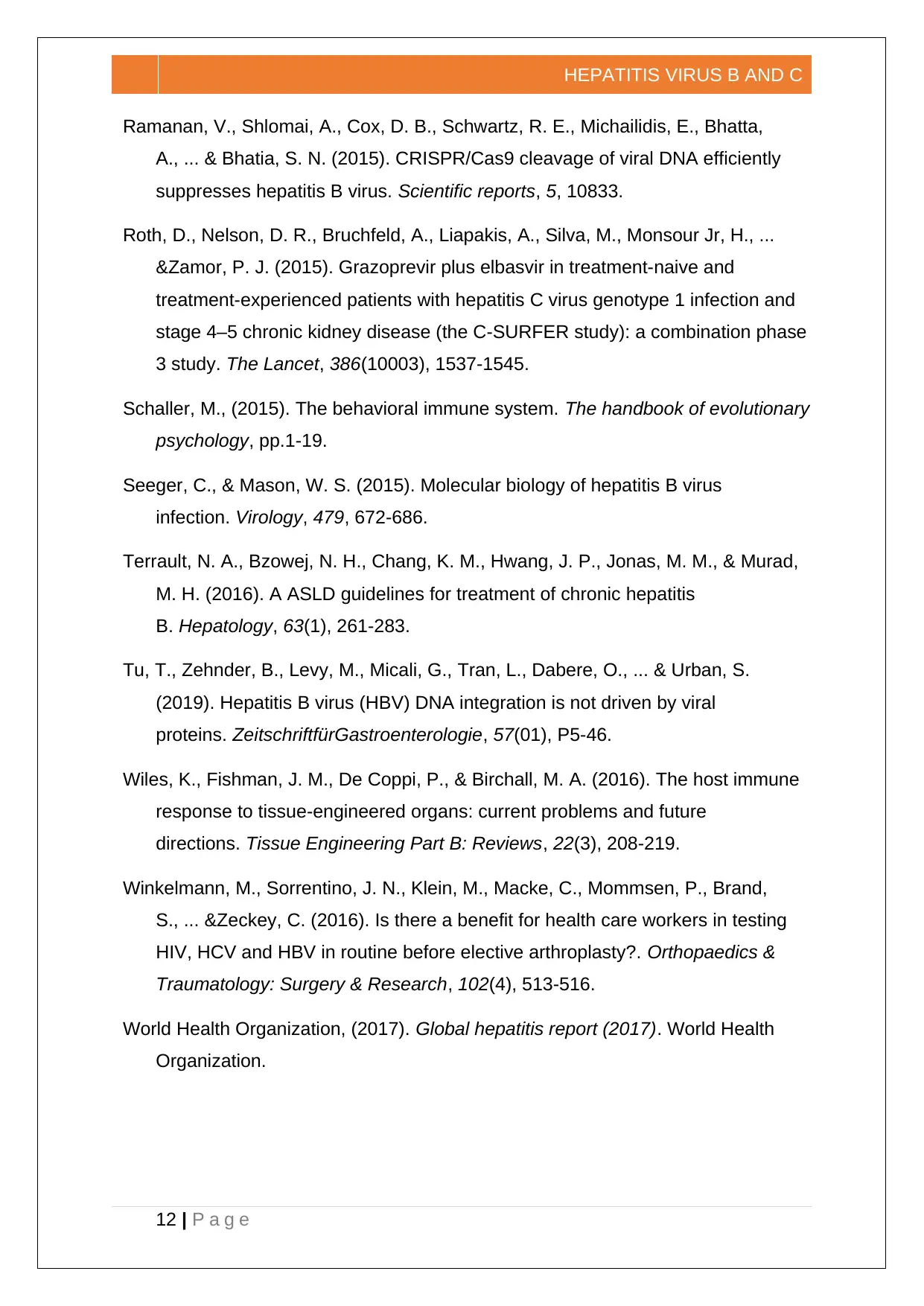
HEPATITIS VIRUS B AND C
Ramanan, V., Shlomai, A., Cox, D. B., Schwartz, R. E., Michailidis, E., Bhatta,
A., ... & Bhatia, S. N. (2015). CRISPR/Cas9 cleavage of viral DNA efficiently
suppresses hepatitis B virus. Scientific reports, 5, 10833.
Roth, D., Nelson, D. R., Bruchfeld, A., Liapakis, A., Silva, M., Monsour Jr, H., ...
&Zamor, P. J. (2015). Grazoprevir plus elbasvir in treatment-naive and
treatment-experienced patients with hepatitis C virus genotype 1 infection and
stage 4–5 chronic kidney disease (the C-SURFER study): a combination phase
3 study. The Lancet, 386(10003), 1537-1545.
Schaller, M., (2015). The behavioral immune system. The handbook of evolutionary
psychology, pp.1-19.
Seeger, C., & Mason, W. S. (2015). Molecular biology of hepatitis B virus
infection. Virology, 479, 672-686.
Terrault, N. A., Bzowej, N. H., Chang, K. M., Hwang, J. P., Jonas, M. M., & Murad,
M. H. (2016). A ASLD guidelines for treatment of chronic hepatitis
B. Hepatology, 63(1), 261-283.
Tu, T., Zehnder, B., Levy, M., Micali, G., Tran, L., Dabere, O., ... & Urban, S.
(2019). Hepatitis B virus (HBV) DNA integration is not driven by viral
proteins. ZeitschriftfürGastroenterologie, 57(01), P5-46.
Wiles, K., Fishman, J. M., De Coppi, P., & Birchall, M. A. (2016). The host immune
response to tissue-engineered organs: current problems and future
directions. Tissue Engineering Part B: Reviews, 22(3), 208-219.
Winkelmann, M., Sorrentino, J. N., Klein, M., Macke, C., Mommsen, P., Brand,
S., ... &Zeckey, C. (2016). Is there a benefit for health care workers in testing
HIV, HCV and HBV in routine before elective arthroplasty?. Orthopaedics &
Traumatology: Surgery & Research, 102(4), 513-516.
World Health Organization, (2017). Global hepatitis report (2017). World Health
Organization.
12 | P a g e
Ramanan, V., Shlomai, A., Cox, D. B., Schwartz, R. E., Michailidis, E., Bhatta,
A., ... & Bhatia, S. N. (2015). CRISPR/Cas9 cleavage of viral DNA efficiently
suppresses hepatitis B virus. Scientific reports, 5, 10833.
Roth, D., Nelson, D. R., Bruchfeld, A., Liapakis, A., Silva, M., Monsour Jr, H., ...
&Zamor, P. J. (2015). Grazoprevir plus elbasvir in treatment-naive and
treatment-experienced patients with hepatitis C virus genotype 1 infection and
stage 4–5 chronic kidney disease (the C-SURFER study): a combination phase
3 study. The Lancet, 386(10003), 1537-1545.
Schaller, M., (2015). The behavioral immune system. The handbook of evolutionary
psychology, pp.1-19.
Seeger, C., & Mason, W. S. (2015). Molecular biology of hepatitis B virus
infection. Virology, 479, 672-686.
Terrault, N. A., Bzowej, N. H., Chang, K. M., Hwang, J. P., Jonas, M. M., & Murad,
M. H. (2016). A ASLD guidelines for treatment of chronic hepatitis
B. Hepatology, 63(1), 261-283.
Tu, T., Zehnder, B., Levy, M., Micali, G., Tran, L., Dabere, O., ... & Urban, S.
(2019). Hepatitis B virus (HBV) DNA integration is not driven by viral
proteins. ZeitschriftfürGastroenterologie, 57(01), P5-46.
Wiles, K., Fishman, J. M., De Coppi, P., & Birchall, M. A. (2016). The host immune
response to tissue-engineered organs: current problems and future
directions. Tissue Engineering Part B: Reviews, 22(3), 208-219.
Winkelmann, M., Sorrentino, J. N., Klein, M., Macke, C., Mommsen, P., Brand,
S., ... &Zeckey, C. (2016). Is there a benefit for health care workers in testing
HIV, HCV and HBV in routine before elective arthroplasty?. Orthopaedics &
Traumatology: Surgery & Research, 102(4), 513-516.
World Health Organization, (2017). Global hepatitis report (2017). World Health
Organization.
12 | P a g e
⊘ This is a preview!⊘
Do you want full access?
Subscribe today to unlock all pages.

Trusted by 1+ million students worldwide
1 out of 12
Related Documents
Your All-in-One AI-Powered Toolkit for Academic Success.
+13062052269
info@desklib.com
Available 24*7 on WhatsApp / Email
![[object Object]](/_next/static/media/star-bottom.7253800d.svg)
Unlock your academic potential
Copyright © 2020–2025 A2Z Services. All Rights Reserved. Developed and managed by ZUCOL.




